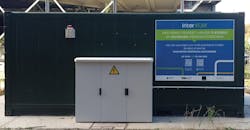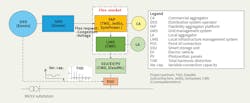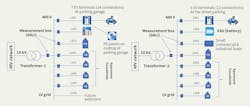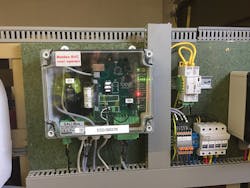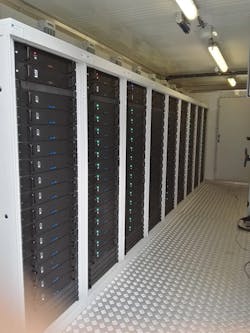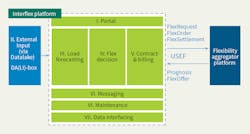Distribution Network Modernization in the Netherlands
The second largest distribution system operator in the Netherlands, Enexis Netbeheer B.V., is one of the front-runners in modernizing the existing energy network infrastructures and facilitating the energy transition. As part of the Horizon 2020 Research and Innovation Programme of the European Union, the Interflex project includes six demonstration projects conducted by five distribution system operators (DSOs) in five European countries.
The Dutch pilot project — being conducted in the city of Eindhoven in a location with residential and business customers — focuses on the integration of local battery storage in the electricity network, several public charging facilities for electric vehicles (EVs) and energy production from photovoltaic (PV) panels. The utility aims to solve congestion problems in the network efficiently while maintaining voltage quality within the standard limits. The project is scheduled to be completed by the end of 2019.
Distribution Networks
Existing distribution networks are shifting toward a more decentralized configuration. An increasing amount of distributed energy resources — like PVs, wind turbines and new types of loads such as electric vehicles (EVs) and heat pumps—rapidly are being connected to the network. The demand for electric and mobility increases the peak load, while large-scale PV integration causes bidirectional power flows in the network.
The dynamic condition of the distribution network creates various operational challenges, among which congestion management and maintaining acceptable voltage quality are the most important issues. Traditionally, DSOs reinforced their networks to prevent and mitigate congestion. Alternatively, the integration of decentralized battery storage at the neighbourhood level also has become a popular solution for balancing the local demand and supply of electrical energy.
Pilot Project
For the pilot project in Eindhoven, Enexis selected the Strijp-S neighbourhood because it has many elements of a smart grid, including a local smart storage unit (SSU) at the distribution substation level, EV facilities, generation from PV, smart adjustment of customers’ loading, smart meters and the measuring system “distributed automation light” (DALI) for low-voltage (LV) networks. The selected neighborhood consists mainly of residential apartments.
In the medium-voltage (MV) and LV distribution substations, all the outgoing LV feeders and secondary side of the MV/LV transformer are connected to DALI measurement boxes that record real-time load data. The neighbourhood has EV charging facilities in a parking garage and roadside parking areas. There is speculation simultaneous charging of EVs will cause overloading of the LV underground cables and MV/LV distribution transformers. It also may result in various voltage-quality problems in the network such as voltage variations and voltage unbalance. However, it is expected the local SSU will provide some power and voltage support during high-load situations to prevent congestion and voltage problems in the grid.
As a DSO, Enexis is responsible for operation, maintenance and development of the distribution network within its territory. This includes providing adequate network capacity and maintaining the voltage-quality criteria. In this project, several market parties serve as commercial and local aggregators. The role of a commercial aggregator (CA) is defined as a demand service provider that combines multiple short-duration flexibility sources for sale or auction in established energy markets. The local aggregator (LA) is responsible for collecting and bundling local flexibility into larger aggregated flexibility offerings to the CA. The LA can do this by contracting flexibility sources.
The LA controls various flexible energy resources and can offer flexibility to the DSO in a flex market. To obtain flexibility from the local flex market, various systems are required such as a grid management system (GMS) operated by the DSO, flexibility aggregation platform operated by the CA and local infrastructure management system operated by the LA. The GMS stores real-time energy data and can forecast the expected load demand for the next few hours. This enables Enexis to decide on purchasing flexibility from the flex market. There is no guarantee all flexible energy requests to the market can be solved by the aggregators.
In the event of the risk of unresolved flexibility, a mitigation measure is available through another mechanism known as the variable connection capacity. In this approach, the DSO provides a signal to the LA to limit the connection capacity of the SSU. This concept is being developed and tested in the Interflex project in combination with the flex market. Enexis anticipates these two methods will enable it to manage network congestion more efficiently.
In this project, two knowledge institutions in the Netherlands, ElaadNL and TNO, are working in close cooperation with Enexis. ElaadNL is a leading organisation for the development of smart charging protocols in Europe. TNO is building a technologically smart grid platform with open interfaces, creating a flexible grid based on new business models. Both these partners support Enexis to develop knowledge on the charging infrastructure, interfaces and algorithms in a typical electricity distribution network.
Network Configuration
The MV distribution networks in the Netherlands typically are a ring-shaped design, connecting various MV/LV distribution substations. Each MV ring has an open point that enables the MV network to operate radially.
In the Strijp-S distribution network, two adjacent MV/LV distribution substations on the same MV ring have been chosen for the Interflex pilot project. Each MV/LV distribution substation is equipped with a 630-kVA transformer that supplies eight outgoing LV feeders. Four outgoing LV feeders from substation 1 supply 198 apartments, while an additional 146 apartments are supplied by substation 2.
Seven charging points, each with two outlets for EV charging in the parking garage, are supplied by transformer 1. Six charging points, each with two outlets positioned in nearby streets, are supplied by transformer 2. The remaining LV feeders supply small commercial and industrial loads as well as other facility management services in the apartment buildings. One LV feeder from distribution substation 2 is connected to the SSU dedicated for this pilot. Each LV feeder and secondary winding of the distribution transformers are connected to the DALI measuring box, which records electrical data such as voltage, current, active and reactive power, and total harmonic distortion (THD) in 15-minute intervals.
Use Cases
The three main objectives of the Interflex project are as follows:
- Determine the various ways to use the existing network’s capacity efficiently.
- Explore alternative methods such as a flex-market mechanism that might help to prevent and defer network reinforcement.
- Introduce SSUs at the neighbourhood level for use as an ancillary service, experimenting with the variable-connection-capacity concept.
The goal is to get hands-on experience in understanding how a DSO can use flexibility to develop a cost-effective grid infrastructure. Knowledge obtained from this project also will enable Enexis to create scalable and positive business cases for all stakeholders. Three use cases currently are being tested in this project.
The first use case aims to demonstrate the applicability of a large-scale centralized storage unit at the substation and street level to exhibit demand-side management. The deployed capacity of the centralized storage unit is in the range of 250 kW. Enexis and the involved aggregators will test and validate the application of an SSU for congestion management, energy trading through spot market and ancillary service provision, and voltage support locally in the network.
The second use case aims to conceptualize and implement the systems necessary to achieve grid flexibility using EV systems. The involved partners will test and validate a technical framework for realizing DSO-requested flexibility from EVs. This helps to develop knowledge on the applicability and future scalability of the concept. They also will gain an in-depth understanding of how flexibility can be managed between the DSO and multiple aggregators as well as how the required systems should interact. The involved aggregators can validate the maturity of the communication chain and its protocols.
The third use case aims to validate the usability of an integrated flex market — technically, economically and contractually — based on the combination of an SSU and EV chargers. Multiple aggregators offer flexibility from flexible sources on a flex market so the DSO can procure flexibility for grid-supporting services. This use case will help Enexis to grow its knowledge of the applicability and future scalability of the concept as well as gain an understanding of how flexibility can be traded between the DSO and multiple aggregators. In addition, the involved partners will learn about the monetary value that flexibility can offer their business. Two scenarios will be tested for this use case:
- Day-ahead market
- Intraday market.
Project Progress
The procurement, development, and implementation of various network components and tools started in 2017. The field-testing of software and testing of network components at manufacturers’ sites are complete.
The GMS is designed for day-ahead and intra-day markets, and it can be executed iteratively multiple times a day. This system gives the necessary insight into the local energy grid to solve congestion by using the flex market. It uses smart algorithms to decide where and when flexibility is needed. The GMS consists of several modules:
- External input — Load forecast is based on actual field measurement from DALI boxes, daily prognoses of the aggregators, market-energy prices and weather forecasts.
- Load forecasting — The historical measurements are used to predict day-ahead energy demand and consumption of the customers as well as the power flows on the networks.
- Flex decision — The main engine of GMS is the flex decision module. It consists of several self-learning algorithms. If congestion is predicted, the module defines a price the DSO is willing to pay for solving the congestion.
- Messaging — If flex is needed, a flex request is sent to the aggregators connected to the congestion point based on the universal smart energy framework (USEF).
- Portal — The portal is a graphical interface that gives administrators an overview of messaging and system errors. It enables the viewing of local load balancing, which is controlled by a load manager.
The EV charging points are installed already. Each EV charging point has a three-phase connection and features car communication technology. Each charging point consists of two sockets with a maximum capacity of three-phase 63 A each. The charging capacity always is divided optimally among the sockets in use.
In this project, all outgoing LV feeders and the MV/LV transformer’s secondary side are equipped with DALI boxes that measure various electrical parameters of the network. Every 15 minutes, measurement data is recorded and stored in a big database, which can be retrieved any time using the web-based network tool. The DALI system consists of voltage and current sensors that send data using wireless communication.
SSU Installation
In Strijp-S, the SSU has been installed. It is a mobile 20-ft (6-m) container with sound suppression. The SSU currently is being used mainly for load congestion management and local voltage support, including short-term power quality issues such as voltage dip and reactive power support. The installed capacity of the SSU is 315 kWh, with the inverter power of 255 kW (bidirectional). The SSU uses lithium nickel-manganese-cobalt-oxide (Li-NMC) battery technology and has 126 modules.
The battery system in the SSU consists of nine racks, and every rack has its own battery management system. The master controller collects all data and communicates to the specified aggregators. The battery loading information can be obtained by the LA. This also can be accessed by using the DALI box, which is connected at the terminal of the SSU. The SSU can operate 200 cycles to 250 cycles per year when the depth of discharge is restricted to 80%. The SSU has a life expectancy of 10 years.
Summary
The Dutch Interflex project meets the primary goals of deploying smart grid management techniques and integrating local energy sources into the network to make the energy transition target feasible. The flexibility market and variable connection capacity mechanisms currently are being field-tested from which Enexis will gain expertise about the applicability of these concepts in a real network situation. The test scenarios are being validated with respect to market prices.
By completing this project, Enexis expects to achieve hands-on experience providing effective EV charging facilities to customers without load congestion and voltage problems. Using a smart grid management technique, the need for additional investment in network capacity can be minimized.
This project also will enable Enexis to develop technical know-how on various open interfaces and open protocols for the GMS. This knowledge and expertise can be used for future scalability of the smart grid development concepts in other parts of the network. Also, the multiple aggregators offer flexibility from different flexible sources (such as SSU and EV chargers) in a flex market. This will help Enexis, as a DSO, to work together with other market parties and gain experience operating in a flexibility market as well as energy trading system.
The success of this pilot will be judged by measuring the effectiveness of the flex market, effectiveness of the SSU for voltage quality management, and the potential to shift load to reduce power peaks and overall impacts to the network.
Acknowledgement
This project has received funding from the European Union’s Horizon 2020 Research and Innovation Programme under grant agreement 731289.
For more information:
ElaadNL | www.elaad.nl
Enexis | www.enexis.nl
TNO | www.tno.nl
Interflex Project Site | https://interflex-h2020.com
About the Author
Sharmistha Bhattacharyya
Sharmistha Bhattacharyya holds a Ph.D. degree in electrical engineering from the Eindhoven University of Technology. She has several years of experience in power system consultancy and utility asset management. Since 2016, she has worked for Enexis Netbeheer B.V. as a senior consultant. Bhattacharyya has expertise on power quality issues in the electrical network and is involved in various other smart grid projects in the Netherlands.
